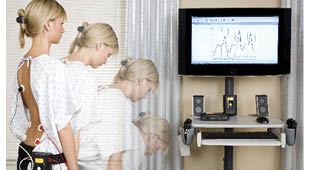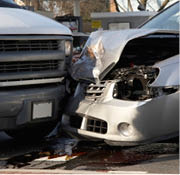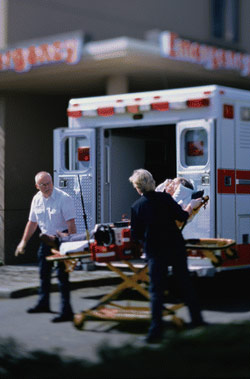:dropcap_open:P:dropcap_close:icture yourself driving home late one night with your spouse from a concert downtown. Your normal route is under construction, so you have to detour through a part of town that you don’t ever like to be in, but certainly not at this hour. As you lean over to push the lock button on your doors, you realize there are not very many cars on the road at this hour, and your senses go on hyper alert.

All of sudden you look up and the car to your left swerves in front of you and has come to a complete stop. There’s no time for you to react, and you plow into the back of the vehicle, jolting your head forward.
As the dust settles and your adrenaline is pumping, you can’t think but help to yourself, “It’s like they came out of nowhere!”
This scenario is called a swoop and scoop, and it’s a classic method of fraudulently staging an auto accident. According to insurance companies PR departments and lobbyists this is an all too common scenario, and a source of billions of dollars in wasted resources. Many would argue that these blatantly illegal and fraudulent acts are isolated incidents that are perpetuated by a very small group of individuals, but there are numerous states where legislative battles are being waged based on the premise of saving consumers money by decreasing fraud.
Almost all efforts to make it more difficult for physicians to bill personal injury protection (PIP) insurance are grounded in these so-called “anti-fraud measures”. While fraud and abuse are very real concerns, the problem is that the proposed measures often do very little in actually combatting fraudulent activities. Several states are currently a battleground for major legislative changes that could impact the ability of chiropractors to help car accident victims recover from their injuries.
There are currently 12 states that still have no-fault auto insurance systems. The term “no-fault” refers to the fact that regardless of which driver was determined to have caused the accident both drivers are eligible for personal injury protection benefits through their own respective insurance carriers.
The 12 no-fault states as of this writing are Florida, Hawaii, Kansas, Kentucky, Massachusetts, Michigan, Minnesota, New Jersey, New York, North Dakota, Pennsylvania, and Utah. Each state’s laws differ dramatically with respect to the amount of PIP, litigation thresholds, and various other factors.
The concept of no-fault auto insurance was developed over 40 years ago by Robert Keeton and Jeffrey O’Connell, two law school professors who felt it would reduce the amount of wasteful litigation costs and allow policyholders to efficiently receive medical benefits and lost wages after an accident.
The statutory limits of PIP benefits vary widely state to state. New York drivers are eligible for $50,000, while motorists in Utah are required to carry only $3,000 in PIP benefits. In virtually every state where mandatory PIP benefits exist, insurance carriers are working hard to enact legislative changes to eliminate no-fault status or make access to benefits increasingly difficult.
National news has been made recently in Florida with the passage of House Bill 119 which significantly limits the ability of patients to receive access to treatment in the no-fault system. Florida has long been a popular destination for chiropractors, in large part because of the favorable personal injury laws and scope of practice. This bill essentially creates a two tier system of injuries, a fairly similar approach taken by the Canadian province of Ontario. After the crash the patient is eligible for $2500 in benefits that will cover treatment by an MD, DO, DC, PA, ARNP, or dentist. Massage therapy and acupuncture are no longer covered benefits under the new system in Florida.
If the $2500 is exhausted, an MD, DO, PA, or ARNP (notice chiropractors are blatantly discriminated against) must diagnose the patient with an “emergency medical condition” (EMC) so that the patient will be eligible for the remaining $7500 in benefits. In HS 119 an EMC is defined as:
“Acute symptoms of sufficient severity such that the absence of immediate medical attention could reasonably be expected to result in:
- Serious jeopardy to patient health
- Serious impairment of bodily function
- Serious dysfunction of any bodily organ or part”
It is safe to assume that insurance companies will not simply reinstate the patient’s benefits on the written opinion of a medical provider. Determining whether a whiplash injury meets the criteria of an EMC will largely rest on the ability of physicians to provide objective diagnostic evidence of injury such as stress view x rays, Digital Motion X Ray (video fluoroscopy), or thin slice proton density MRI.
:dropcap_open:Eliminating chiropractic care as a viable option for accident victims will limit patients from treatment that has been shown to be highly effective for the treatment of whiplash.:quoteleft_close:
It is obvious that “soft tissue injury”, as commonly treated by chiropractors following motor vehicle collisions will be a hotly contested issue. The criteria for an EMC is so loosely defined in the law that it will become even more important than in the past to utilize established standards of care and “gold standards”. The good news for patients and providers alike is that the American Medical Association Guides to the Evaluation of Permanent Impairment considers spinal ligament trauma to be a condition that qualifies for all of the criteria outlined in the new Florida law. Additionally, the National Guideline’s Clearinghouse, which falls under the purview of the Department of Health and Human Services has established clear protocols for the diagnosis and treatment of whiplash injuries.
It is quite likely that the insurance carriers will attempt to override the medical provider’s diagnosis of an EMC, so it will become paramount that there is concrete proof of ligament trauma in order to win the disputes. Since very few medical physicians have an appreciation for spinal ligament injuries on the level that chiropractors trained in evaluating motor vehicle collision occupant injuries do, this presents a huge opportunity, which we’ll discuss later.
Unfortunately, Florida is not the only state where battles are being waged over no-fault benefits. The New York State Senate Insurance Committee has held a series of hearings designed to prevent fraud and abuse. At face value this appears to be a very reasonable effort, and likely needed in many cases. Ellen Melchionni, president of the New York Insurance Association said the proposed legislation “contains numerous remedies, including giving insurance carriers adequate time to investigate fraud, encouraging efficient and fair settlement of disputes and creating tougher penalties for fraud.”
While no honest provider would ever want to see an increase in fraud, any provision that increases the amount of time insurance companies have to “investigate fraud” is typically a code word for delaying or denying claims. Carriers have a point system used to red flag a claim as fraudulent, as some of the measures used might alarm you. For example, if multiple patients from a single accident are being treated by the same doctor or have the same attorney, this could be viewed as potentially fraudulent by a carrier. The treatment of young children after a crash is also a potential fraud trigger. There is an absolute need to combat fraudulent activities like staged accidents and billing for services that weren’t rendered, but giving an insurance carrier more latitude to delay paying legitimate claims is not likely one of them.
Minnesota is another state where the auto insurance system is being targeted. No-fault benefits have existed in this state since 1975, and pressure from insurance companies is causing the Minnesota Senate Commerce Committee to consider changes in how claims are processed. According to Bob Johnson, President of the Insurance Federation of Minnesota, “(Some of the cost increases are) due to fraud and abusive and excessive treatment of patients by aggressive providers who know the system is susceptible to being gamed. Being able to apply cost controls to the system will help lower costs to consumers by reigning in providers who treat outside the mainstream of what is considered acceptable care.”
The problem with this statement is that the insurance companies likely have a very different determination of “acceptable care” than many providers. Accepted standards such as the Croft Guidelines can be used to provide a concrete standard of how much treatment is reasonable or necessary, but many insurance carriers will still likely consider this amount of treatment to be “abusive and excessive”.
PIP reform in New Jersey that is currently taking place focuses on the ability of providers to dispute bills with insurers, a process called arbitration. Marshall McKnight, spokesman for the New Jersey Department of Banking and Insurance, says over 58,000 arbitration filings were made and thousands were “frivolous”. In many no-fault states there are similar avenues that doctors can utilize when they believe that a claim is not being handled fairly by the insurer.
:quoteright_open:Even if you’re like a majority of the chiropractors reading this, and you do not practice in a no-fault state, it is still time to stand up for our profession.:quoteright_close:
While there are likely a small handful of doctors who abuse this system, placing limits a provider’s ability to dispute an unfair denial is a very slippery slope. In many states these arbitration processes are often the only leverage that exists for physicians to ensure that they treated fairly. If there is a need for reform it needs to take place with reasonable discussions between insurance carriers, providers, and legislators, not with press releases blanketing the news outlets written by insurance lobbyists.
If you currently practice in a no-fault state, it is important that you take action as quickly as possible. Your state association likely has a list of key state legislators involved in the decision making process, as well as a list of talking points to contact them with. Not only should you email your representatives yourself, but encourage your patients to do the same.
If you have a practice Facebook page or Twitter account, leverage the power of social media to spread the word to your patients and community. If the only voice they hear comes from the talking points provided to the local news outlets by the insurance company, it’s easy for them to develop biased and potentially harmful viewpoints. You can even set up an internet connected laptop in your waiting room underneath a sign explaining the need for their involvement, allowing them to easily email key decision makers.
Most importantly, there is massive opportunity that exists in a state of chaos. The chiropractic profession is at a crossroads, and I believe the next few years will go a long way in determining the future of our industry. The blatant attempts by the insurance industry to marginalize chiropractic and spinal ligament injuries can only be combated by making clear, objective documentation of ligament trauma the standard of care. I often use the analogy that these injuries are like “ACL tears in the spine”, but carry much more severe long term consequences.
There is no profession better educated and positioned to establish a position as experts in the field of ligament injury and conservative treatment strategies than chiropractic. This will create chances to educate personal injury attorneys as well as medical providers as to the serious consequences of these injuries, and how they can be properly diagnosed and treated. Now is the time in invest in personal injury training and coaching programs that can provide you with the ammunition to provide rock solid documentation and communicate effectively with attorneys and medical physicians.
Even if you’re like a majority of the chiropractors reading this, and you do not practice in a no-fault state, it is still time to stand up for our profession. As we’ve seen with the scope of practice discrimination in Texas, decisions are not made in a vacuum. When insurance companies develop a strategy to limit the rights of honest physicians in one state, this tactic often spreads nationwide. Contact your state or local association and get a list of key talking points as well as who you can email or call. This is not only the right thing to do for our profession, but it may ultimately help save your practice down the road.
Dr. Jonathan Walker is president of PI Marketing Elite, a company dedicated to helping doctors see more new PI patients. Visit www.pimarketingelite.com or call 904-616-1284 to speak with Dr. Walker directly.
 Chiropractors believe they are immune and can fly under the radar of insurance audits and fraud investigations. Unfortunately, you can’t avoid the radar. Insurance companies have been establishing utilization profiles for years and they know your every move.
Chiropractors believe they are immune and can fly under the radar of insurance audits and fraud investigations. Unfortunately, you can’t avoid the radar. Insurance companies have been establishing utilization profiles for years and they know your every move.

 You may consider a “smoke and mirrors” strategy and employ a program to beat or “bust” the insurance companies’ computer systems. How many other doctors in the healthcare community practice those standards? The answer is very few, and it can be seen as a way to obfuscate the facts in order to gain more business from the legal community. This tactic can be used against you in the courtroom when representing your patients, or in front of a licensure board while defending your license by using tactics that are not consistent with other healthcare providers and specifically designed toward winning legal cases versus representing the findings of your patients. You do not need smoke and mirrors to win, only clinical excellence, and there are no shortcuts. This avenue renders potential significant exposure.
You may consider a “smoke and mirrors” strategy and employ a program to beat or “bust” the insurance companies’ computer systems. How many other doctors in the healthcare community practice those standards? The answer is very few, and it can be seen as a way to obfuscate the facts in order to gain more business from the legal community. This tactic can be used against you in the courtroom when representing your patients, or in front of a licensure board while defending your license by using tactics that are not consistent with other healthcare providers and specifically designed toward winning legal cases versus representing the findings of your patients. You do not need smoke and mirrors to win, only clinical excellence, and there are no shortcuts. This avenue renders potential significant exposure.
 The last attorney I interviewed said the following: “With the chiropractor as primary, I never know, until the end, whether I have a good case or bad one. It almost always ends up as the professional opinion of the DC versus that of the MD. And, although I mean no disrespect, the public has a natural tendency to take the word of the MD.”
The last attorney I interviewed said the following: “With the chiropractor as primary, I never know, until the end, whether I have a good case or bad one. It almost always ends up as the professional opinion of the DC versus that of the MD. And, although I mean no disrespect, the public has a natural tendency to take the word of the MD.”

 Prior to digesting the new legislation and rendering a plan for success, one must understand that this is a huge opportunity for those that position themselves appropriately. The legislation prescribes a blueprint to go well beyond the $10,000 PIP cap if clinically indicated. The new legislation also provides a means for reasonably caring for patients at the usual and customary fees, not subject to 80% of the 200% Medicare fees, and allows for unlimited necessary care without being exposed to independent medical examinations (IMEs) or examinations under oath (EUOs).
Prior to digesting the new legislation and rendering a plan for success, one must understand that this is a huge opportunity for those that position themselves appropriately. The legislation prescribes a blueprint to go well beyond the $10,000 PIP cap if clinically indicated. The new legislation also provides a means for reasonably caring for patients at the usual and customary fees, not subject to 80% of the 200% Medicare fees, and allows for unlimited necessary care without being exposed to independent medical examinations (IMEs) or examinations under oath (EUOs).

 All of sudden you look up and the car to your left swerves in front of you and has come to a complete stop. There’s no time for you to react, and you plow into the back of the vehicle, jolting your head forward.
All of sudden you look up and the car to your left swerves in front of you and has come to a complete stop. There’s no time for you to react, and you plow into the back of the vehicle, jolting your head forward. 

 How does this help your practice? A complete EHR system streamlines your practice in many ways, leading to increased income, higher patient visit averages, and greater productivity by your staff. A patient, signed in at the front desk, automatically appears on the doctor’s computer in the adjusting/treatment area. Entering a diagnosis in the documentation end of the EHR instantly places it in the billing area. The services the doctor documents generate the charges for the day as the patient checks out. Since the EHR system is producing the charges based on the SOAP note, the documentation and billing always match. When the patient signs out electronically, the patient’s signature shows that the patient witnessed that the services billed have been provided and that the patient is ultimately responsible for the charges. This provides both audit and collection protection for you.
How does this help your practice? A complete EHR system streamlines your practice in many ways, leading to increased income, higher patient visit averages, and greater productivity by your staff. A patient, signed in at the front desk, automatically appears on the doctor’s computer in the adjusting/treatment area. Entering a diagnosis in the documentation end of the EHR instantly places it in the billing area. The services the doctor documents generate the charges for the day as the patient checks out. Since the EHR system is producing the charges based on the SOAP note, the documentation and billing always match. When the patient signs out electronically, the patient’s signature shows that the patient witnessed that the services billed have been provided and that the patient is ultimately responsible for the charges. This provides both audit and collection protection for you.
